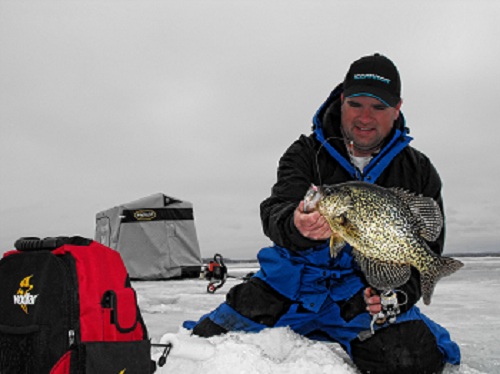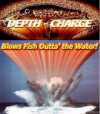Even on lakes with good structure and good weed growth, it seems like a percentage of panfish, both crappies and bluegills will pull out and suspend over holes and troughs at first ice. On many bodies of water, most of the panfish will be suspending over these deeper basin areas by mid winter. A good starting point is to simply look for the hole or basin that is close to the lush weed growth or flooded timber where many of these fish summer. In years past, these deep basin fish were often a big fish pattern as finding suspended fish that were roaming through this wide water column were difficult for anglers to target, like finding a needle in a haystack. With technology and better equipment however, finding these nomadic trophies has gotten much easier.
Both sonar along with GPS mapping are crucial tools for finding basin orientated suspended fish. The advantage a flasher gives you is pretty obvious. Not only does a flasher indicate how far off the bottom to fish but also the mood of the fish. When fishing suspended fish, I like to watch the whole water column as there are many times where it seems like I am reeling up or dropping down to different fish that are coming through at staggered depths so I avoid the zoom features. What is really important however is reading the mood or aggressiveness of the fish with your flasher. In my opinion, nothing beats a Vexilar for indicating how the fish is reacting to the presentation. The Vexilar units do an excellent job of displaying the mood of the fish because the dial has more lines of resolution and the signal is unfiltered. In a nutshell, when a fish moves through the cone angle on a Vexilar, the signal will flutter. When the fish stops, the signal will steady and darken. This is why you don’t get the choppy lines when you are dropping a lure down through the water fast when using a Vexilar. By reading this signal, you can really react to the mood of the fish much more so which can be crucial for these deep suspended fish.

The author Jason Mitchell specially designed a fast action finesse spring bobber specifically for fishing soft plastics and this system is deadly on crappie and bluegill |
Another piece of electronics that I just have a hard time leaving home without is a GPS with a lake contour map if available. By just having my position in correlation to a contour lake map seems to help me not only break down this open water but also focus on edges, contours and funnels where the density of fish might be higher |
Besides giving you the big picture in regards to your exact location on a big sheet of ice, GPS allows you to save and remember the subtle sweet spots. Small depressions or bumps on the bottom can often focus fish movements and good locations or holes can be saved and returned to. Even with fish that are suspending over basins or holes… irregular features on the bottom just makes some zones fishy.
As far as the nuts and bolts of the presentation, I firmly believe that these fish can and will move a considerable distance to check something out. I like to start on the large side of the lure spectrum just to gauge the general reaction. Particularly for crappie, I like to start with small swim lures like Northland Tackle Puppet Minnows or the tiny Salmo CD3 Chubby Darters and when I fish these tiny swim lures, I am making an effort to see how high I can get fish to shoot up. If I can get a school or even an individual fish to rise vertically and gain speed, the fish often turn aggressive. One of the best things you can do for getting fish wound up below you is raise them and get the school to stack vertically. This same concept can also be applied to sunfish but you might have to switch the presentation to a small spoon like a Forage Minnow packed with wax worms.
If fish won’t raise more than a few feet and seem hesitant, you might have to back off of the aggressive presentations and use more finesse. Particularly when the sun gets higher, you might have to rely on some smaller finesse presentations at some point each day. For this deep water fishing where you might have to get down over twenty feet of water or more, tungsten is tough to beat for getting down fast and the extra weight also enables you a little better control and feel when fishing small profile jigs in deep water. A sweet combination is a Northland Tackle Mooska Jig tipped with an Impulse plastic tail. The extra weight of the tungsten really brings the tail to life and basically the action you are looking for is just a quiver that causes the tail to dance in place. We actually developed a spring bobber rod in the Jason Mitchell Elite Series line up called the Micro Bite which was built for using plastics in this type of situation as the light spring adds a lot of subtle action to the tail which triggers panfish.
The other secret weapon for presenting small jigs into deep water is the use of Fluorocarbon line. Some people have embraced fluorocarbon because of the zero visibility characteristics of this line but what I like is the weight of the line. Fluorocarbon is heavy and sinks through the water faster than monofilament. The best fluorocarbon line on the market for ice anglers is the Bionic Fluorosilk which is actually a monofilament line with a fluorocarbon sheath or covering which makes the line sink faster. Combine this line with a tungsten jig and use with the right rod action/ spring bobber and you have a deadly presentation for deep crappies and bluegills when some subtleness and finesse is required.
There is no doubt that these tools have revolutionized and opened up this basin exploration. With the right equipment, some of the largest and most difficult schools of fish become accessible to anglers.
Editors Note: The author, Jason Mitchell is credited with pioneering several of the advanced ice fishing tactics on the ice right now. Jason Mitchell also hosts the outdoor program, Jason Mitchell Outdoors which airs on Fox Sports North and Fox Sports Midwest at 9:00 am Sunday mornings.







